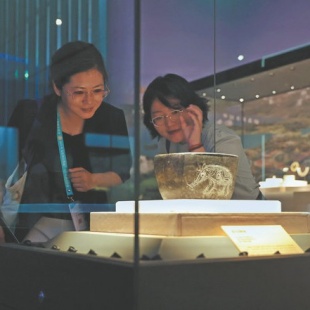Exhibition zooms in on Yangtze's tide of history


A replica of the Homo erectus cranium from Yunxian county, Hubei province — known as the Yunxian Man, dated to nearly a million years ago, offers the first glimpse into human origins in the Yangtze River Basin, as featured in the Vital Origins chapter.
This part explores early human activities and the shared genetic roots of Chinese civilization, with highlights such as jade artifacts from the Neolithic archaeological site of Liangzhu in Zhejiang province, painted pottery and jade ware from Shijiahe site dating back about 5,900 years in Hubei province.
Though the original of the cranium is housed at the Chinese Academy of Sciences and rarely displayed, the replica is paired with a newly completed forensic facial reconstruction, unveiled publicly for the first time in December 2024, says Wang Wenbin, associate research curator at the Changsha Museum.
The two exhibits are put in a broader and relatively complete sequence of Paleolithic human remains in the Yangtze region — spanning from 1.7 million to 20,000 years ago, with the juxtaposed display of other notable finds, such as the Hexian Man dating to 200,000 years ago from Anhui province, distinguished by the rich diversity of physical traits, Wang notes.
Further down the exhibition, the basin's pioneering role in rice domestication is notably demonstrated by a centerpiece — charred rice remains from the Shangshan culture in Zhejiang — dating back over 10,000 years.
Accompanying relics giving a bigger picture include carbonized rice husks from the Jijiaocheng site dating back to between 5,300 and 4,000 years in Hunan, as well as paddies and various earth-turning implements from iconic ancient sites such as Yuchanyan in Hunan and Hemudu in Zhejiang that are believed to be used like modern shovels.
"These remains offer decisive evidence that early Yangtze communities were actively cultivating rice," Wang says.





































